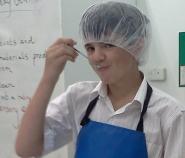Technological products and outcomes in food technology
Teaching inquiry
How can I grow my year 10 students’ understanding of technological products and the characteristics of technological outcomes through practical food technology activities?
Introduction
Gill Mandley found that she could increase students' understanding of technological products and the characteristics of technological outcomes by:
- identifying the relevant indicators of progression and translating them into a foods context
- introducing vocabulary and concepts alongside practical activities
- providing opportunities for the students to explore and experiment with ingredients.
Background and planning
Whenever the students in Gill Mandley’s year 10 class cooked a dish, they would dutifully discuss the ingredients using the vocabulary of technological products. But in reality, they were quite happy to cook an appetising product from a given recipe without understanding why the ingredients worked as they did.
So it was not surprising that when they were asked to come up with a heat-and-eat product (product development, term 2) they couldn’t get beyond pizza, macaroni cheese, and other familiar food products.
Gill thought that if her students had a better understanding of ingredients they would produce more innovative outcomes:
I decided I would turn the programme on its head and explained to the class that we are actually going to think about, explore, and play with ingredients to allow them to become more innovative and experimental when they develop new products.
Gill Mandley
Technological products in a foods context
Gill could see that what a food technologist needs to know and understand about ingredients closely aligns with what students are expected to understand for the technological products component of the technological knowledge strand. So she translated the indicators for technological products into a foods context.
For level 3, students need to understand:
- the performance properties of a range of ingredients – and use these to suggest things that the ingredients could be used for
- how ingredients are manipulated to make a food product – and use feasible ways of manipulating a range of ingredients
- why particular ingredients are selected for particular food products
- the properties of ingredients in food products that can be measured objectively and subjectively
- how the properties of ingredients combine to allow a food product to be technically feasible and socially acceptable.
Gill also decided to introduce the terms manipulation and formulation from the level 4 indicators.
Indicators of progression: Technological products
Characteristics of technological outcomes in a foods context
The level 3 indicators for characteristics of technological outcomes include:
- Describe possible users and functions of a technological outcome (food product) based on clues provided by its physical attributes
- Describe examples of technological outcomes (food products) with different physical natures that have similar functional natures.
Indicators of progression: Characteristics of technological outcomes
Gill decided that, at first, she would relate the concepts of physical and functional attributes only to ingredients – and then apply them to food products in the latter part of the unit.
Gill had recently had a Royal Society Fellowship at Westland Milk Products. While there, she had put the Body of Knowledge on the wall and asked technologists to interpret it in terms of their practice in the milk factory. In the resulting discussion, she realised that ice cream would be a food product with great potential for developing understandings about technological products as envisaged by the curriculum.
As she planned a new two-term unit, Gill resolved to focus on the technological products component in the first term and, in the second, she would challenge her students to use their knowledge of ingredients to develop their own layered dessert.
Implementation
From the outset, Gill placed an emphasis on structured repetition of specialist vocabulary as a means of growing understanding of key concepts. This involved regular oral use, word walls, and literacy activities. Language also featured in daily learning intentions.
Year 10: Draft lessons, term 1 (Word 2007, 27 KB)
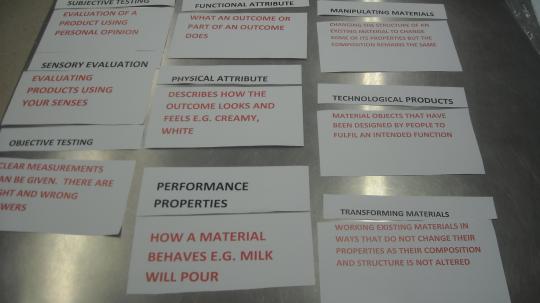
Revisiting sensory evaluation
The students used their year 9 experience of sensory evaluation to help them develop their own ice-lollies from a range of given ingredients. They revisited rating and ranking methodologies and revised sensory evaluation vocabulary with the aid of laminated cards.
They discussed how the concepts of physical and functional attributes might apply to ingredients.
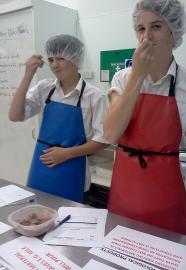
With this groundwork in place, the students then went on to look at a range of vanilla ice creams. They did a blind sensory evaluation, in which they considered flavour, texture, and appearance, and they tried to identify the ingredients used from a given list. To lend authenticity to the technology practice, Gill used a code system to identify the different ice creams. This ensured that established preferences for a particular brand or variety did not influence the evaluations. The students recorded their observations for each ice cream on a grid with five headings (brand name, ingredients, functional properties, nutrients, and sensory descriptors). The same exercise was repeated with chocolate ice creams.
When they go on to develop their own products, students need to have a range of sensory tests in their toolkit, know what information each provides, and know when to use them – this is standard practice for any food technologist.
Ranking tests (Word 2007, 14 KB)
Making and evaluating ice cream
The students then made batches of ice cream using a class recipe.
Vanilla ice cream recipe (Word 2007, 15 KB)
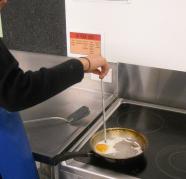
The recipe had an egg custard base that curdled easily, and some students took several goes to get it right. This led to useful discussion on the function of the egg and the physical attributes of the curdled custard.
Further exercises involved poaching eggs under controlled conditions with the help of a thermometer. These gave the students additional experience with objective and subjective testing and helped them understand why the custard may have curdled.
The students were then introduced to star diagrams as a tool for recording and comparing sensory evaluations. First they specified their “ideal” combination of characteristics (sweetness, texture, and so on) and represented these as a star. Then they rated their own and others’ homemade vanilla ice creams, recording their findings on stars printed on tracing paper. By laying these stars over their “ideal” star, the students could see if their confection had the desired characteristics. If it didn’t, they had to identify what they would do differently next time.
The British Nutrition Foundation site Food for Life has an overview on sensory evaluations on the ingredients page.
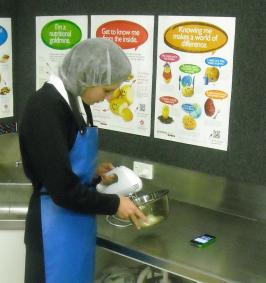
Now that her students were familiar with the base recipe (vanilla), Gill challenged them to create their own chocolate ice cream, choosing from a range of possible flavourings. She questioned them as they worked, to make sure that they were thinking about what they were doing:
- “Why are you going to add the chocolate at that point?"
- “What will happen to the temperature when you add the chocolate to the mixture you are chilling in the water bath?"
- “Why do you think the chocolate has gone lumpy?"
- “What happened when you melted the chocolate on the stove?”
The students compared the characteristics of ice cream that had been churned in an ice cream maker and ice cream that had been put straight into the freezer. They also experimented with ice-cream toppings and sauces, brandy snaps, meringues, and a Swiss roll. These provided plenty of scope for questions and rich conversations on transformation and manipulation.
Researching ice cream
Alongside their practical work, students researched the history of ice cream, its worldwide spread, and its nutritional value. To guide their research, they were given a series of questions.
Ice cream research task (Word 2007, 15 KB)
Working in groups, the students had to create a brief presentation or report on their findings.
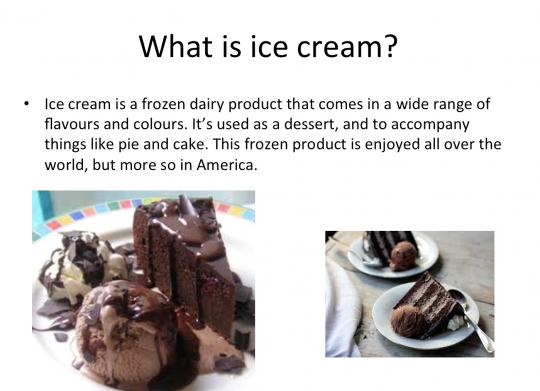
Ice cream presentation: Group 3 (PowerPoint 2007, 2 MB)
Concluding the unit
The unit concluded with a test, in which most of the questions related to technological products, characteristics of technological outcomes, and food preparation skills. Knowing that certain students would struggle with the literacy demands, Gill arranged for them to have reader-writers.
Year 10 test: End of term 1 (Word 2007, 41 KB)
The students did some chocolate moulding for Valentines Day and Easter. For many students, this was a highlight of the unit.
Outcome
Gill says:
From my classroom observations, most of the students have grasped how to carry out the rating and ranking tests. Several need further help with the star diagram test. Half can see the purpose of the different tests, but I clearly need to do some more teaching around this.
Gill Mandley
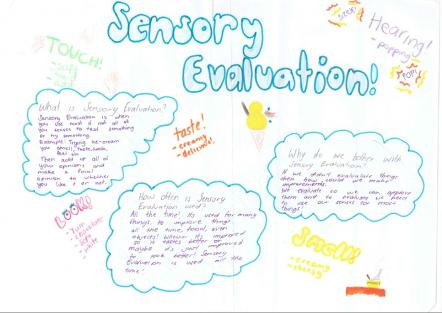
Student work: Sensory evaluation (PDF, 348 KB)
Towards the end of the first part of the unit, the students were given a variety of agents (such as gelatine, flour, cornflour, eggs, lemon jelly crystals, arrowroot, lemon juice, lime juice, and flavourings) and very limited instructions – and were told to see what they could come up with. They were surprisingly confident in their experimentation, and enjoyed the exercise. Gill felt this vindicated her new approach.
Beacon Practice facilitator Paul Neveldsen comments:
The change in practice was very important – placing directed activities related to specific indicators alongside the more practical aspects appears to help embed the understandings.
Paul Neveldsen
Gill’s strategy of standing back and supporting the students to experiment with ingredients and processes is not about setting them up for failure but about exploring outcomes. The fact that they were all exploring the same product outcome (ice cream) did not diminish the effectiveness of the approach – all were learning all the time. Engagement was a non-issue.
As a result, a number of students changed their second half-year option to extension food technology, and some decided that in year 11 they would do the full food technology programme.
What next?
The next time she does this unit, Gill plans to have her students record their growing understandings in a logbook or journal.
We were so busy discussing and questioning what was happening that we didn’t do enough in the way of evidence collection.
Gill Mandley
Next term, students will work in groups to develop a layered dessert for a chosen stakeholder and special occasion. Each group will also develop a product that is based on or incorporates a particular ingredient (for example, sausages or breadcrumbs).
Student handout: Cold set dessert (PDF, 40 KB)
Cold set desserts: Teacher's draft notes for nest steps (PDF, 45 KB)
The programme will also include aspects of food labelling plus more on the composition of ingredients and how this relates to their physical and functional attributes and performance properties. This will develop understandings that students will need in year 11, as assessed by AS91049 Demonstrate understanding of how materials enable technological products to function.

